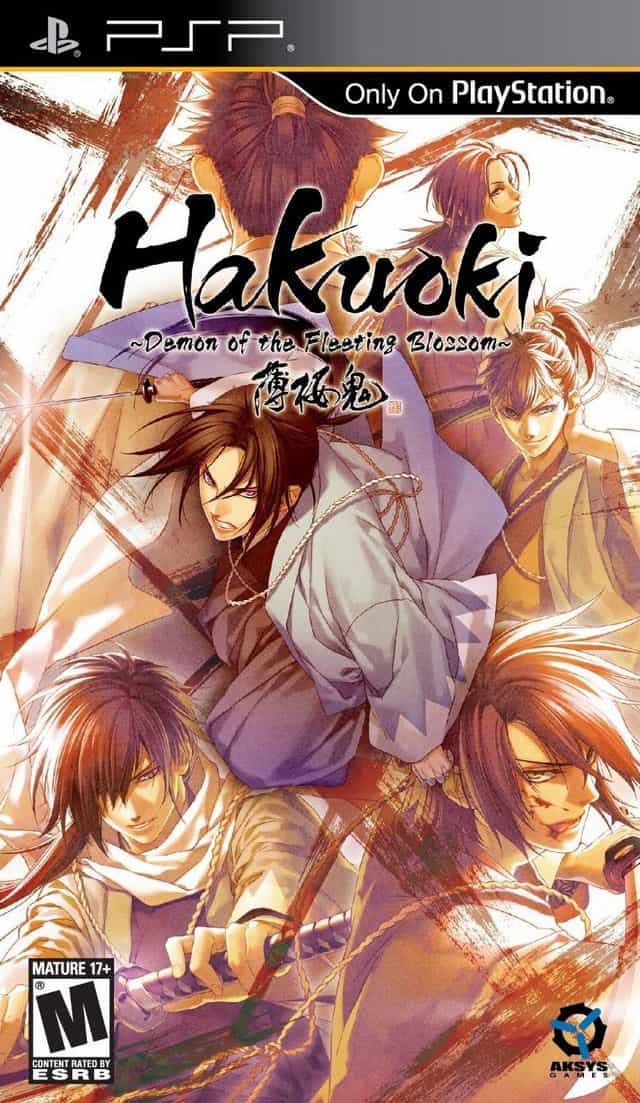Love Blooms In The Chaos Of War
From True Blood to Twilight , supernatural romance has become a very popular genre in North America. Because of this, Hakuoki: Demon of the Fleeting Blossom was a wise choice for Aksys Games to make when introducing Japanese otome games to this continent. The otome genre involves story-heavy games in which a female protagonist experiences a romance with one of several possible male love interests, but there’s a lot more to Hakuoki than that. This historical fiction interactive novel is set in a tumultuous time in Japanese history and adds healthy dose of supernatural horror to spice up the mix—though don’t worry, absolutely nobody sparkles in the sun.
The first half of Hakuoki introduces readers to Chizuru, the main character who has traveled to Kyoto in the late 1800s, looking for her missing father. After accidentally witnessing a horrifying murder committed by a group of inhuman killers, Chizuru is taken in by the Shinsengumi, Kyoto’s semi-official police force dedicated to protecting the populace as Japan’s long ruling Tokugawa shogunate begins to unravel. In this section of the game, Chizuru gets to know the Shinsengumi captains, has the chance to participate in a number of bloody battles as the group goes about its work, and learns several dangerous secrets.
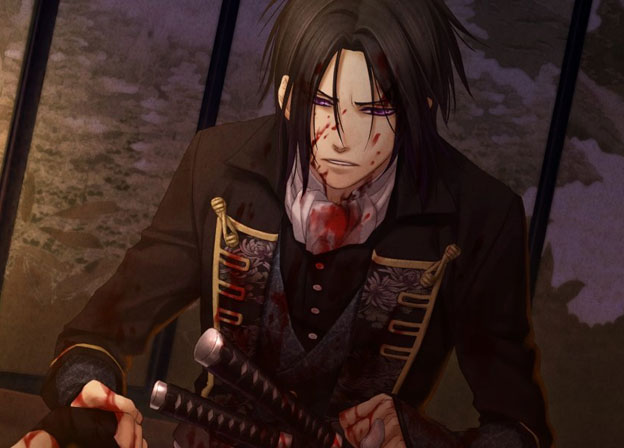
The later part of the game is where the romantic storyline kicks in, but it’s certainly not all sighs and kisses. The Shinsengumi are on the losing end of history as supporters of the falling shogunate, and the supernatural sub-plot presents major challenges to the game’s characters as well. There are many tragic and bittersweet moments in this part of the game, and players shouldn’t expect a Hollywood happy ending. Getting the “good” ending for a particular character isn’t too difficult if the player has paid close attention to the story, at least, and making the right choices gives the satisfying feeling of seeing love and humanity triumph over hatred and inhumanity.
Although steeped in Japanese history and culture, Hakuoki avoids most of the anime tropes that Westerners tend to find obnoxious. The game’s female characters are strong, dignified people who never descend into giggly irrelevance. The Shinsengumi tend to subvert stereotype: the strong, quiet Saito actually has a fair amount to say and is often outwardly kind, joker Okita can actually be rather cruel, and the young Todo’s exuberance is realistic rather than overbearing. Nobody, thank all the blessed deities, ever bursts out with a rousing speech about the power of friendship. In fact, the bonds that tie these men together are portrayed as strong but complex, and some of them break as the story develops.
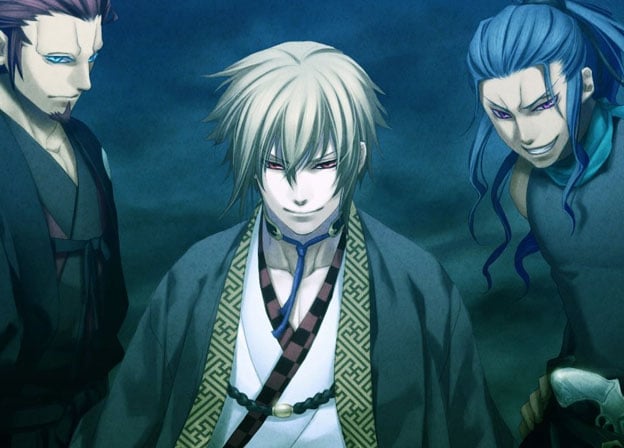
That story is a compelling one, with many tense and exciting moments. It has been excellently localized by Aksys Games, in particular when it comes to describing the many bloody battles that the Shinsengumi experience. The more frequently the player chooses to send Chizuru out with the Shinsengumi, the more both she and the reader are confronted with the gruesome reality of living as a warrior in a society that is falling apart. Although the most gruesome scenes aren’t depicted visually, the descriptions bring them vividly to life and most certainly earn the game its M rating. That’s not to say there aren’t quieter moments as well, which are also penned evocatively. I only saw a couple minor spelling errors in the text, which is impressive considering the amount of text in the project and the small size of the team that took it on.
The words “player” and “reader” can be used fairly interchangeably when describing the experience of Hakuoki, as there is no real gameplay to speak of. This is basically a “Choose Your Own Adventure” novel brought to life with pictures and sound. Storyline choices come around less frequently than one might expect, but they are always meaningful. During the first half of the game, Chizuru’s choices determine which Shinsengumi she gets to know best and whether anybody develops romantic feelings for her. She is usually rewarded for making active choices rather than sitting back in self-doubt, something that should please most female players. The second half of the game splits the story completely depending on which of the five or six love interests Chizuru chooses, (the sixth is only available on a replay of the game) giving the story a great deal of replayability. Particularly in the first half of the game, it’s difficult to know what the result of most of Chizuru’s decisions will be, so I advise the player to just go with the flow on the first playthrough, then experiment with the choices later on.
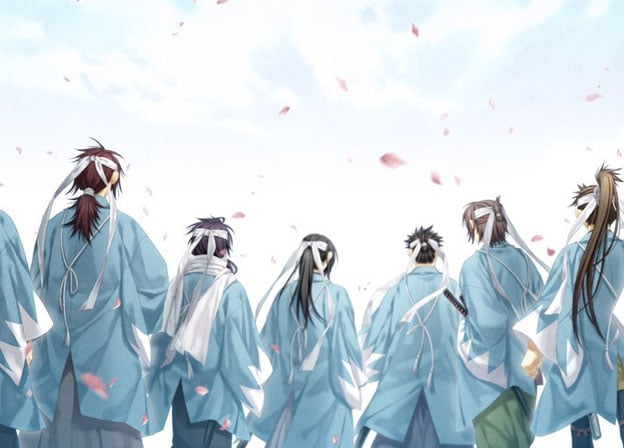
The game’s sparse UI and tools make the experience of playing and replaying the game quite pleasurable. The text speed is adjustable and the player can choose to fast-forward through text that has been read previously, allowing the game’s first half to progress swiftly on replay. There’s an encyclopedia that helps the player keep track of characters and defines historical and cultural terms, as well as a status screen that helps the player keep track of Chizuru’s romance level with the eligible bachelors. A “Record of Service” also allows players to start a new game from any major point in the story—perfect for a reader who wants to see how a particular character’s storyline could end differently. A first playthrough of the story will take five to seven hours, but subsequent playthroughs will only take about three hours if the reader chooses to fast-forward through repeated text segments in the story’s first half.
Hakuoki’s graphics are mostly limited to still images that illustrate the story. They’re quite lovely, however, fitting well with the setting and emphasizing the personalities of the various characters. The Shinsengumi are quite attractively designed and all the characters are easy to tell apart, which is important in a game with such a complex tapestry of historical figures. The game could have used a few more background images for the less-important scenes, during which the reader sees the same small set of Japanese rooms and outdoor vistas over and over.
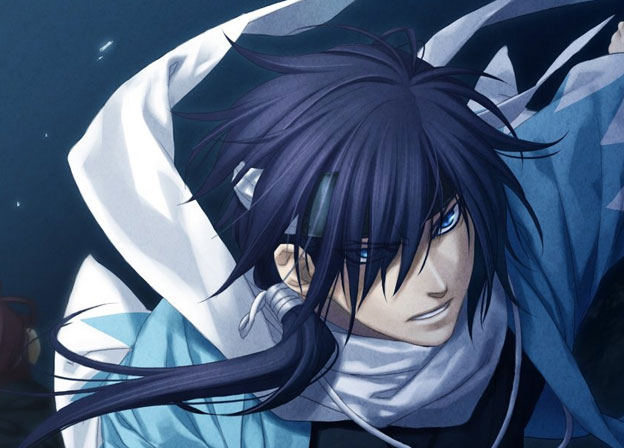
The music is entirely unmemorable but provides a pleasant background to the story. Much of the dialogue is voiced in Japanese, (English dubbing would no doubt have been financially difficult for a project like this) and the voice actors are generally pleasing to the ear while providing a diverse array of voices. The only wrong note is Haisuke Todo’s voice actor, who is too shrill and fails to impart Todo’s increasing maturity as his character develops through the story.
Hakuoki is far from a usual gaming experience here in the West, but it was an excellent choice for Aksys to make in introducing us to both visual novels and otome games. Although an attraction to men is helpful for enjoying the character artwork and the romantic subplots in the game, there are plenty of themes and scenes that will appeal to all gamers. That said, it’s refreshing to see a game that is designed for women without descending into pink chiffon and shopping. Hakuoki takes us seriously as readers and gamers, and I would love to see more games do so in the future.
Thanks to an addictive, well-written story and six completely different possibilities for the second half of the game, Hakuoki is a compelling interactive fiction experience. It’s certainly not a typical game, but it shows us why we should make room for visual novels in our gaming landscape. Gamers should take a chance on this one, either for themselves or to share with a non-gaming friend or lover who would enjoy this kind of story. They might be surprised to find that Hakuoki has the power to draw people into its world and make them care about Chizuru and her Shinsengumi friends.
RATING OUT OF 5 RATING DESCRIPTION 3.9 Graphics
The still images that illustrate the game are beautiful, but there could stand to be more of them. 4.4 Control
The game’s controls and UI make reading and repeat play pleasurable. 3.5 Music / Sound FX / Voice Acting
The background music does its job well, and all but one of the Japanese voice overs are pleasant to listen to. 4.0 Play Value
Compelling to read and very well-translated, Hakuoki invites players to experience all six of its character storylines. 4.0 Overall Rating – Great
Not an average. See Rating legend below for a final score breakdown.
| Review Rating Legend | |||
|---|---|---|---|
| 0.1 – 1.9 = Avoid | 2.5 – 2.9 = Average | 3.5 – 3.9 = Good | 4.5 – 4.9 = Must Buy |
| 2.0 – 2.4 = Poor | 3.0 – 3.4 = Fair | 4.0 – 4.4 = Great | 5.0 = The Best |
Game Features:
